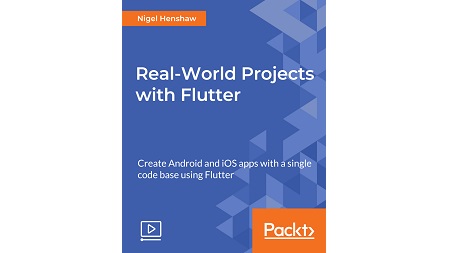
English | MP4 | AVC 1920×1080 | AAC 48KHz 2ch | 4h 04m | 843 MB
Develop powerful Android and iOS applications with just one code base with Flutter using this hands-on guide
Flutter is quickly becoming a well-known framework for developing cross-platform apps for both Android and iOS devices. Apps made with Flutter are very fast because of their high rendering power. This course is for developers who have been studying Flutter but have hit some roadblocks in the next steps of their development. The course is designed to bridge any questions or issues that you may have while creating complete Android and iOS applications.
This course models real-world problems and then teaches the steps and techniques for creating solutions in the form of complete Android and iOS applications. With Flutter, you’ll develop multiple apps for both stores with just one code base. You’ll be able to build app layouts, perform widget animation, pull and push data to servers, and compile codes and release to both stores.
By the end of this course, you’ll have the skills and confidence to start creating Android and iOS apps straight away with Flutter.
This course will model true to life situations with practical real-world solutions. At the start of each project, a problem or issue will be presented. Then it’s straight into development where you’ll be shown best practices, techniques, tools, and libraries to create Flutter applications rapidly.
What You Will Learn
- Implement material design widgets to create beautiful layouts
- Decode JSON with models to communicate with remote services
- Add Google maps, routes, and places to create comprehensive map applications
- Detect images to discover the powerful machine learning APIs with the Firebase ML Kit
- Manage state changes using the Scoped Model, Bloc and Redux architecture patterns
- Migrate content to the cloud with Firebase authentication, database, and storage solutions
- Build robust code with Unit, Widget, and Integration testing
- Build and release applications to publish to the Google Play Store and App Store
Table of Contents
Create a My Weather App
1 The Course Overview
2 Create Mockup UI to Visualize the App
3 Implement the Widget Tester to Test the Weather Widget
4 Get JSON Weather Data to Display the Live Weather
5 Add Location Support to Display Local Weather
6 Create Unit Tests for Testing API Methods
Build a Coffee Finder App
7 Integrate Google Cloud Support to Access Google Maps
8 Integrate Location with Maps to View Local Location
9 Use Google Maps Web Service for a List of Nearby Cafes
10 Use Google Map Markers to Display the Cafes
11 Create Card to Display Cafe Information and Route
Develop a Coffee Store App
12 Create Home Page to Visualize Look and Feel
13 Create Carousel for Switching between Drinks
14 Integrate Scoped Model Design Pattern for Sharing State
15 Add AlertDialog for Placing Drinks Order
16 Implement Integration Tests for Testing Entire App
Make a Payments App
17 Create Mockup UI for App Look and Feel
18 Create QR Codes for Coffee Shop Products
19 Use Firebase ML Kit to Detect QR Code
20 Set Up Camera for QR Code Scanning
21 Use BLoC Pattern to Manage State Changes
Craft a Selfie App
22 Create Mockup UI for App Look and Feel
23 Use the Camera Plugin for Capturing Images
24 Implement Gallery to Display Image Thumbnails
25 Use Flutter Redux for Managing State Change
26 Build and Release for Publishing Android Apps
Build a Chat App
27 Create Mockup UI for App Look and Feel
28 Implement Google Sign In for Login
29 Use Cloud Firestore to Hold Chat Messages
30 Add Firebase Storage to House Images
31 Build and Release for Publishing iOS Apps
Resolve the captcha to access the links!